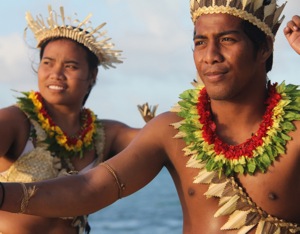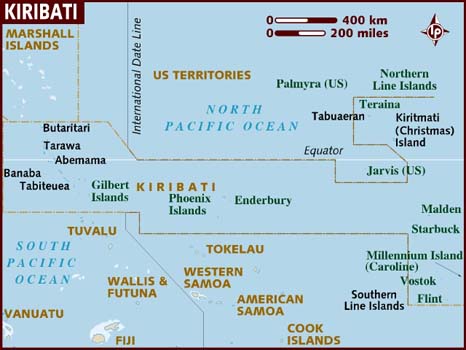“Just for you to hear our voices…This is our only hope.”

In Pacific island cultures, dance can be a form of prayer — which may be why three dozen people from the disappearing coral atolls of Tuvalu, Kiribati and Tokelau are on a fourteen-city US tour with what they see as their futures at stake.
The message: that what we in the United States do here, affects them there. It’s a performance and educational campaign called “Water Is Rising.”
Instead of looking at bar graphs, we heard the beat of sticks on large biscuit tins. No Power Point here, just artfully synchronized hands and hips, fingers and bare feet.
 Along with a boaki, a large wooden drum box, they brought one united plea: “Brothers and sisters in the United States, we are losing our land. We can work together to make us free from climate change.”
Along with a boaki, a large wooden drum box, they brought one united plea: “Brothers and sisters in the United States, we are losing our land. We can work together to make us free from climate change.”
The kick-off to their tour started in the Southland with “Science and Art in a Climate of Change: a Dialogue of Nations,” a performance and conversation sponsored by UCLA’s Center for Intercultural Performance, the Institute of the Environment and Sustainability and the Department of World Arts and Culture.
They had traveled forty hours by boat to Samoa, then boarded a plane for a two-hour flight to Fiji, and then a ten-hour flight to Los Angeles. They came dressed in sarongs and t-shirts and cotton dresses, and adorned with pandanus skirts and head wreathes. They brought their dances and their songs to a UCLA stage.
The dancers sang in familiar three-part harmony while the scientists, students and the rest of us listened in the darkened theater. Mikaele Maiava from Tokelau told us they are losing one to two meters of land a year along their shores. Andrew Semele from Tuvalu says the tuna they rely on for export are getting scarce because the waters are now too warm. Frances Tebau from Kiribati says their well water is getting too salty to drink. “This is our only hope,” Tebau says. “Go for renewable energy. If you could reduce your greenhouse gases… We don’t want to lose our land. We will lose everything.”
“Just for you to hear our voices, my brothers and sisters,” says Andrew Semele. “Just for you to know we suffer. We are here to kindly ask, to look for a shoulder to lean on.”

They’ll be taking their stories to Riverside, California, this week, then on to Arizona, and then east for performances dates in New England, Maryland and a District of Columbia performance at the Kennedy Center.
In between the dances and songs, the head of California’s Air Resources Board, Mary Nichols (still a part-time professor at UCLA) took the stage along with UCLA’s climate scientists to moderate the conversation. Alex Hall, director of UCLA’s Center for Climate Change Solutions, was struck by how irrelevant science can seem in light of the dancing. “This is so eloquent… so interconnected. I don’t think people are really listening to the scientists so I really applaud this effort today.”
Funding for tour has come from UCLA, various foundations, and the National Endowment for the Arts. Inspiration and vision came from Judy Mitoma, a former dancer who now heads UCLA’s intercultural Performance Center.
5 thoughts on “Pacific Islanders Dance for Sea Rise Awareness”
Comments are closed.

Is the sea levels really rising? An Auckland University researcher has offered new hope to the myriad small island nations in the Pacific which have loudly complained their low-lying atolls will drown as global warming boosts sea levels.
Geographer Associate Professor Paul Kench has measured 27 islands where local sea levels have risen 120mm – an average of 2mm a year – over the past 60 years, and found that just four had diminished in size.
Working with Arthur Webb at the Fiji-based South Pacific Applied Geoscience Commission, Kench used historical aerial photographs and high-resolution satellite images to study changes in the land area of the islands.
They found that the remaining 23 had either stayed the same or grown bigger, according to the research published in a scientific journal, Global and Planetary Change.
“It has been thought that as the sea level goes up, islands will sit there and drown,” Prof Kench told the New Scientist. “But they won’t.
“The sea level will go up and the island will start responding.
Anything coming out of the mouths of Maldives officials related to climate, CO2, or sea level is pure bullshit.
The only purpose of it is to continue to paint Maldives as a victim, so they’ll get some of that climate cash promised by the fools that attend these climate conferences. Meanwhile, they continue to expand their travel industry, build new resorts, build new airports, and promote tourism while laughing all the way to the bank.
In response to Russell Steele’s comment above:
1. The inundation of atolls is not scientifically well understood and is certain to be complex. The fact is that it does occur, regardless of any research offering “new hopes” that may be presented. Rising sea levels are an obvious and serious threat to atolls and thus their inhabitants.
2. The Maldives are in the Indian Ocean, not the Pacific, and there is no Maldivian involvement in this dance group.
3. The GDP of Tokelau, one of the island groups that is involved, is the smallest in the world. Note that it possesses a negligible travel industry, not a single resort (one “hotel”), and no airstrips let alone airports. It does not even have a bank (that one can laugh on the way to).
http://en.wikipedia.org/wiki/List_of_countries_by_GDP_(PPP)
Therefore, these performers are motivated by reasonable and justifiable concerns. To state that their “only purpose” is to victimize themselves for financial gain is an affront to their considerable dignity and is a reflection of misplaced priorities and a retarded capacity for understanding that should be apologized for.
Russell Steele…
to read what you just wrote makes me sad, if you have time in your life, please do visit some of these island nations who have come a long from their homes to ask you for help…
see with your own eyes how they are surviving with climate change, hope you stop reading from articles and news and go see yourself, than later you can make a view on the situation.
tourism is not for these Islands.. too pour even to have good roads how could they have good hotels, .. do not mistaken these smaller poorer islands than the other bigger richer pacific islands..
if the UN Secretary-General Ban Ki-moon can warn over climate change threat to Pacific islands after visiting Kiribati i think you will think the same too..
peace & love from the Pacific
Climate Cash?
This story is about the islands of Kiribati, Tuvalu, and Tokelau all of which live traditional, independent lives and receive little tourism. There message is for the people of the world to pay attention to climate change. Calling their message bullshit is not productive, it is arrogant.
Some research shows that despite sea level rise doubling some atolls are continuing to grow. Great. But that’s not the end of the story. Not for science at least. Continued investigation and attention will provide a more knowledgeable perspective. Because the geologic history shows that these islands have been in and out of the water repeatedly over millions of years and understanding how that happens on a small timescale and how global climate change will effect it is a complex question. It was only one to two thousand years ago that these islands came out of the water during a prolonged period of climate stability. What destabilizing our climate over the past 100 years will mean is more than one geographer can answer.
These are tiny islands that are normally ignored. Good on the people of these islands to travel so far to receive some attention.
I’m one of the “B_ ll_ _ _tters” apperantly. I live in the dance troupe from Tokelau’s village. My house is 20 metres from the lagoon and sits on wooden posts at 120cms above ground. It is a beautiful sight – paradise itself – a constant trade wind breeze keeping it forever cool – the sun wakes me up daily at 6.00 shining on my face – a tourists’ dream isle even though we do not have many – 3 a year would be an excessive overtourism. During cyclone seasons though,from Nov to March I live in constant worry and fear that my house could be swept away, as the water sweeps in and out under it on a yearly basis, which is great for regulating natural rubbish that accumulates underneath- but there are periodical cyclones of devastation that costs millions of $ we don’t have – we then becaome a burden for NZ, and other big countries. In 2005 was the last devastating cylone (Percy). At its zenith, my family got ready to swim for our lives as the water level reached the highest rung of our steps, and the more vicious waves sloshed and carried out to sea our cooking utesils, outside furniture that we were not able to secure inside as it was full, etc etc. We couldn’t run, let alone swim to the opposite (ocean) side 70 metres away as the waves there were even bigger and stronger…we stayed on out porch, alternating prayer, pleading and cursing about these things. If we had mountains, it would be an escape route but where we live, with the land barely a metre above sea level, a slight rise in the water is not threatening – it’s life and death. You wouldn’t want to get swept out to sea either, as you would surely miss the other 2 islands that make up Tokelau they’re so small, and the closest and highest land fall that could give you succour would be Samoa, a leisurely 600 kms to the South. My point? I want to live, by you changing the way you live. I can’t save the world, I just want to save our atolls for our future generations. I also know our little atolls and its’ people and elders should be utilized globally for their sustainability skills as proven by continually coming up in the past with ways to protect the grain of sand we call home – but, it’s getting too hard with the world doing what its doing to destroy our planet…if you don’t take our message seriously, I and my island will die first, then you shortly, second…Tofa